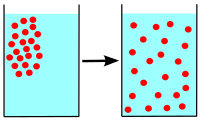
Photo from wikipedia
Context Thermal traits likely mediate organismal responses to changing thermal environments. As temperatures increase, predicting species responses will depend on understanding how thermal traits vary within and among individuals and… Click to show full abstract
Context Thermal traits likely mediate organismal responses to changing thermal environments. As temperatures increase, predicting species responses will depend on understanding how thermal traits vary within and among individuals and across time and space. Objectives We evaluated variation in thermal traits within and among individual Mojave Desert Tortoises, using GPS telemetry to quantify movement performance and animal-mounted sensors to measure carapace temperatures. Methods We constructed thermal performance curves (TPCs) based on movement velocity and assessed variation in associated thermal traits by sex, season, and proximity to roads. We also examined the temperature-dependence of monthly home ranges and the frequency of high-displacement movements. Results Individuals exhibited lower variation in upper critical temperatures (CT maxE ) than in other traits, such as optimum temperatures and lower critical temperatures for movement. All thermal traits varied within individuals, either by season or proximity to roads. We also found that monthly home range size and the frequency of high-displacement movements increased with the time individuals spent within their optimal temperature range; however, this effect was only apparent during months with greater rainfall. Conclusions Low standing variation in CT maxE suggests that this trait may be constrained, limiting potential changes through acclimation or selection in warming environments. Our results demonstrate the modifying effect of rainfall on temperature-space use relationships and highlight the dependence of thermal traits on ecological and landscape contexts. Field-based TPCs derived from GPS movement tracks provided ecologically-relevant estimates of thermal traits and suggest an informative framework for unifying elements of thermal biology and spatial ecology.
Journal Title: Landscape Ecology
Year Published: 2020
Link to full text (if available)
Share on Social Media: Sign Up to like & get
recommendations!